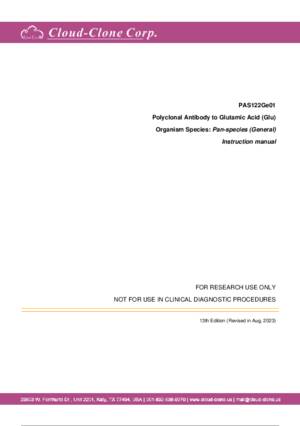Polyclonal Antibody to Glutamic Acid (Glu)
Glutamate
- Product No.PAS122Ge01
- Organism SpeciesPan-species (General) Same name, Different species.
- SourcePolyclonal antibody preparation
- HostRabbit
- Potencyn/a
- Ig Type IgG
- PurificationAntigen-specific affinity chromatography followed by Protein A affinity chromatography
- LabelNone
- Immunogen CPS122Ge21-OVA Conjugated Glutamic Acid (Glu)
- Buffer FormulationPBS, pH7.4, containing 0.02% NaN3, 50% glycerol.
- TraitsLiquid
- Concentration0.5mg/mL
- Organism Species MorePan-species (General)
- ApplicationsELISA, CLIA. / IHC-Fr, ICC, IP (predicted).
If the antibody is used in flow cytometry, please check FCM antibodies. - DownloadInstruction Manual
- UOM 20µl100µl 200µl 1ml 10ml
- FOB
US$ 119
US$ 279
US$ 398
US$ 995
US$ 3980
For more details, please contact local distributors!
SPECIFITY
The antibody is a rabbit polyclonal antibody raised against Glu. It has been selected for its ability to recognize Glu in ELISA and CLIA.
USAGE
Immunohistochemistry: 5-20µg/mL;
Immunocytochemistry: 5-20µg/mL;
Optimal working dilutions must be determined by end user.
STORAGE
Store at 4°C for frequent use. Stored at -20°C in a manual defrost freezer for two year without detectable loss of activity. Avoid repeated freeze-thaw cycles.
STABILITY
The thermal stability is described by the loss rate. The loss rate was determined by accelerated thermal degradation test, that is, incubate the protein at 37°C for 48h, and no obvious degradation and precipitation were observed. The loss rate is less than 5% within the expiration date under appropriate storage condition.
GIVEAWAYS
INCREMENT SERVICES
| Magazine | Citations |
| Neurobiology of Disease | Critical role for Annexin A7 in secondary brain injury mediated by its phosphorylation after experimental intracerebral hemorrhage in rats pubmed:29196215 |
| Nutrients | High-dose Glycerol Monolaurate Up-Regulated Beneficial Indigenous Microbiota without Inducing Metabolic Dysfunction and Systemic Inflammation: New Insights … |
| Journal of neural transmission (Vienna, Austria : 1996) | Neurotransmitter system aberrations in patients with drug addiction Pubmed: 32804296 |
| Mol Med Rep | ¦Ê?opioid receptor agonist, U50488H, inhibits pyroptosis through NLRP3 via the Ca2+/CaMKII/CREB signaling pathway and improves synaptic plasticity in ¡ 34036389 |
| Neuroscience | Ah-type baroreceptor neurons expressing estrogen dependent mGluR7 mediate descending inhibition of cardiac nociception Pubmed:35436518 |
| J Clin Med | Fatty Acid-Binding Protein 7 (FABP-7), Glutamic Acid and Neurofilament Light Chain (NFL) as Potential Markers of Neurodegenerative Disorders in Psoriatic Patients … Pubmed:35566558 |
| J Inflamm Res | The κ-Opioid Receptor Agonist U50488H Ameliorates Neuropathic Pain Through the Ca2+/CaMKII/CREB Pathway in Rats Pubmed:35645576 |
| Catalog No. | Related products for research use of Pan-species (General) Organism species | Applications (RESEARCH USE ONLY!) |
| CPS122Ge21 | OVA Conjugated Glutamic Acid (Glu) | Immunogen; SDS-PAGE; WB. |
| CPS122Ge11 | BSA Conjugated Glutamic Acid (Glu) | Immunogen; SDS-PAGE; WB. |
| PAS122Ge01 | Polyclonal Antibody to Glutamic Acid (Glu) | ELISA, CLIA. / IHC-Fr, ICC, IP (predicted). |
| CES122Ge | ELISA Kit for Glutamic Acid (Glu) | Enzyme-linked immunosorbent assay for Antigen Detection. |
| AES122Ge | ELISA Kit for Anti-Glutamic Acid Antibody (Anti-Glu) | Enzyme-linked immunosorbent assay for Antibody Detection. |
| LMS122Ge | Multiplex Assay Kit for Glutamic Acid (Glu) ,etc. by FLIA (Flow Luminescence Immunoassay) | FLIA Kit for Antigen Detection. |
| KSS122Ge11 | ELISA Kit DIY Materials for Glutamic Acid (Glu) | Main materials for "Do It (ELISA Kit) Yourself". |








